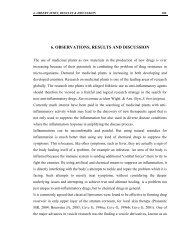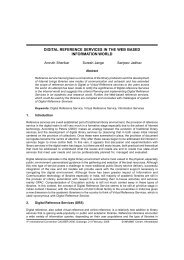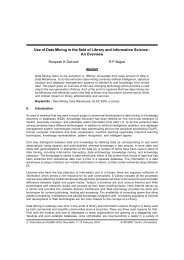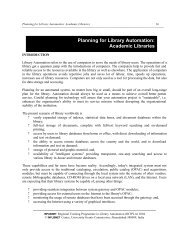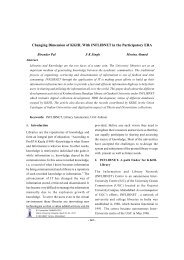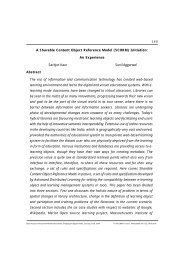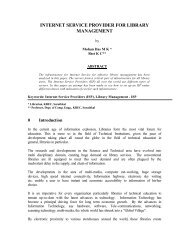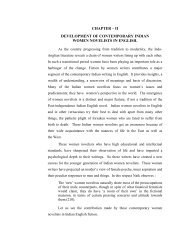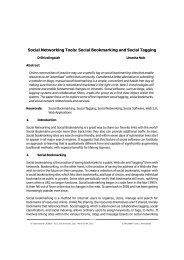Impacts of ICT in LIS: Electronic Publishing - INFLIBNET Centre
Impacts of ICT in LIS: Electronic Publishing - INFLIBNET Centre
Impacts of ICT in LIS: Electronic Publishing - INFLIBNET Centre
Create successful ePaper yourself
Turn your PDF publications into a flip-book with our unique Google optimized e-Paper software.
190<br />
International CALIBER-2008<br />
<strong>Impacts</strong> <strong>of</strong> <strong>ICT</strong> <strong>in</strong> <strong>LIS</strong>: <strong>Electronic</strong> Publish<strong>in</strong>g<br />
Chhama Mishra Archana Saxena<br />
Abstract<br />
Just like all other aspects <strong>of</strong> life, the digital revolution has taken on the world <strong>of</strong> publish<strong>in</strong>g also. With<br />
digital publish<strong>in</strong>g com<strong>in</strong>g to the fore, the publish<strong>in</strong>g world has undergone several fundamental changes.<br />
<strong>Electronic</strong> publish<strong>in</strong>g is basically a form <strong>of</strong> publish<strong>in</strong>g <strong>in</strong> which books, journals and magaz<strong>in</strong>es are<br />
be<strong>in</strong>g produced and stored electronically rather than <strong>in</strong> pr<strong>in</strong>t. These publications have all qualities <strong>of</strong><br />
the normal publish<strong>in</strong>g like the use <strong>of</strong> colours, graphics, images and are much convenient also.<br />
<strong>Electronic</strong> publish<strong>in</strong>g empowers all writers <strong>in</strong> ways that no technology has ever done before. The<br />
use <strong>of</strong> licensed electronic <strong>in</strong>formation resources will cont<strong>in</strong>ue to expand and <strong>in</strong> some cases become<br />
the sole or dom<strong>in</strong>ant means <strong>of</strong> access to content Without violat<strong>in</strong>g any issues <strong>of</strong> privacy or<br />
confidentiality we can dramatically enhance our understand<strong>in</strong>g <strong>of</strong> <strong>in</strong>formation use. The paper attempts<br />
to discuss the impact <strong>of</strong> electronic publish<strong>in</strong>g on Library & Information Science area and radical<br />
changes <strong>in</strong> the publish<strong>in</strong>g <strong>in</strong>dustry especially with impact <strong>of</strong> electronic media and Internet. This<br />
paper attempted to expla<strong>in</strong> and predict ‘<strong>LIS</strong>’ <strong>in</strong>tention <strong>of</strong> adopt<strong>in</strong>g this technology.<br />
Keywords : <strong>Electronic</strong> publish<strong>in</strong>g, <strong>ICT</strong>,<br />
1. Introduction<br />
The impact <strong>of</strong> <strong>in</strong>formation technology has been all pervad<strong>in</strong>g. It has changed the way that <strong>in</strong>formation<br />
is stored and dissem<strong>in</strong>ated and has threatened the traditional approaches to the library and its<br />
services. The ultimate objective <strong>of</strong> any <strong>in</strong>formation system is utilization and exploitation <strong>of</strong> <strong>in</strong>formation<br />
that raise levels <strong>of</strong> education, strengthen community l<strong>in</strong>ks and stimulate participation <strong>in</strong> decision<br />
mak<strong>in</strong>g for development <strong>of</strong> mank<strong>in</strong>d. Information is an <strong>in</strong>tellectual resource that has the capacity to<br />
change the image <strong>of</strong> recipient. In the post<strong>in</strong>dustrial society, it has been said that what counts is not<br />
row muscle power or energy but <strong>in</strong>formation. Consequently, large <strong>in</strong>vestments are be<strong>in</strong>g made <strong>in</strong><br />
the <strong>in</strong>formation technology <strong>in</strong>dustry for the purpose <strong>of</strong> generat<strong>in</strong>g, process<strong>in</strong>g and dissem<strong>in</strong>at<strong>in</strong>g<br />
<strong>in</strong>formation.<br />
The <strong>in</strong>formation produced is dissem<strong>in</strong>ated by different model <strong>of</strong> publish<strong>in</strong>g <strong>in</strong>formation. New<br />
technologies have transformed the process <strong>of</strong> publish<strong>in</strong>g and distribution <strong>of</strong> <strong>in</strong>formation. In view <strong>of</strong><br />
growth <strong>in</strong>formation, electronic publish<strong>in</strong>g has become a foundation for the new <strong>in</strong>formation society<br />
to get the right <strong>in</strong>formation to the right person at the right time. Changes <strong>in</strong> the publish<strong>in</strong>g <strong>in</strong>dustry<br />
have a direct impact on the <strong>in</strong>formation systems and services. This <strong>in</strong>formation technology has<br />
altered the mode <strong>of</strong> publication <strong>in</strong> such a way that though the traditional sources <strong>of</strong> <strong>in</strong>formation<br />
cont<strong>in</strong>ued to be flooded with the attractive electronic form <strong>of</strong> publications. In the chang<strong>in</strong>g scenario,<br />
libraries and librarians will have to play a crucial role <strong>in</strong> handl<strong>in</strong>g conventional and electronic resources.<br />
6 th International CALIBER-2008, University <strong>of</strong> Allahabad, Allahabad, February 28-29 & March1, 2008 © <strong>INFLIBNET</strong> <strong>Centre</strong>, Ahmedabad
191<br />
Thus the era <strong>of</strong> electronic publish<strong>in</strong>g has begun affect<strong>in</strong>g producers, distributors, library and <strong>in</strong>formation<br />
pr<strong>of</strong>essionals. The ultimate goal <strong>of</strong> electronic publish<strong>in</strong>g is to provide fast and easy access to the<br />
<strong>in</strong>formation conta<strong>in</strong>ed <strong>in</strong> the objective publications with simple, powerful search and retrieval<br />
capabilities. Thus, e publish<strong>in</strong>g can be used effectively <strong>in</strong> the context <strong>of</strong> Dr. S.R. Ranganathan’s<br />
fourth law “ Save the time <strong>of</strong> user” for many purposes.<br />
2. <strong>Electronic</strong> Publish<strong>in</strong>g<br />
F.W. Lancaster is one <strong>of</strong> the first pioneers who have been cited more <strong>in</strong> library literature for his<br />
vision <strong>of</strong> E-publish<strong>in</strong>g, predict<strong>in</strong>g that electronic publish<strong>in</strong>g would eventually displace paper-based<br />
publish<strong>in</strong>g methods <strong>in</strong> one <strong>of</strong> his latest article.<br />
Lancaster noted, “True <strong>Electronic</strong> publication implies that authors would compose for a different<br />
medium and <strong>in</strong> so do<strong>in</strong>g would no longer be constra<strong>in</strong>ed by the static limitations <strong>of</strong> the pr<strong>in</strong>ted page<br />
that the pr<strong>in</strong>ted book will be replaced by someth<strong>in</strong>g quite different from anyth<strong>in</strong>g we have yet seem,<br />
and this will occur because the medium replac<strong>in</strong>g it will be widely perceived to be better”.<br />
<strong>Electronic</strong> publish<strong>in</strong>g is the process for production <strong>of</strong> typeset quality documents conta<strong>in</strong><strong>in</strong>g text,<br />
graphics, pictures, tables, equations etc. it is used to def<strong>in</strong>e the production <strong>of</strong> any that is digitized<br />
form. It uses new technology allow<strong>in</strong>g publishers to deliver documents and other contents quickly<br />
and efficiently as well.<br />
<strong>Electronic</strong> Publish<strong>in</strong>g can be represented as<br />
<strong>Electronic</strong> Publish<strong>in</strong>g = <strong>Electronic</strong> Technology + Computer Technology + Communication<br />
Technology + Publish<strong>in</strong>g<br />
One <strong>of</strong> the most complete def<strong>in</strong>ition <strong>of</strong> <strong>Electronic</strong> Publish<strong>in</strong>g appears <strong>in</strong> a popular electronic encyclopedia<br />
( Grolier <strong>Electronic</strong> Publish<strong>in</strong>g, 1995).this wholly electronic publication def<strong>in</strong>es electronic publish<strong>in</strong>g<br />
this way “the term E-publish<strong>in</strong>g refers more precisely to the storage and retrieval <strong>of</strong> <strong>in</strong>formation<br />
through electronic communications media. It can employ a variety <strong>of</strong> formats and technologies,<br />
some already <strong>in</strong> widespread use by bus<strong>in</strong>esses and general consumers and others still be<strong>in</strong>g developed.<br />
E-publish<strong>in</strong>g technology can be classified <strong>in</strong>to two general categories:<br />
<br />
<br />
Those <strong>in</strong> which <strong>in</strong>formation is stored <strong>in</strong> a centralized computer source and delivered to the<br />
users by a telecommunications systems , <strong>in</strong>clud<strong>in</strong>g onl<strong>in</strong>e database services and videotext<br />
represents the most active area <strong>in</strong> E publish<strong>in</strong>g today”, and<br />
those <strong>in</strong> which the data is digitally stored on a disk or other physically deliverable medium.<br />
3. Models <strong>of</strong> <strong>Electronic</strong> Publish<strong>in</strong>g<br />
3.1 <strong>Electronic</strong> Books (E-Books)<br />
The book is quiet popular document to meet the academic and general needs <strong>of</strong> user community.<br />
Project Gutenberg, perhaps the best know publisher <strong>of</strong> book length electronic texts, began <strong>in</strong> 1971
192<br />
with the goal <strong>of</strong> encourag<strong>in</strong>g the creation and unlimited distribution <strong>of</strong> 10,000 electronic texts by the<br />
end <strong>of</strong> the year 2001. These books fall <strong>in</strong>to several ma<strong>in</strong> categories <strong>in</strong>clud<strong>in</strong>g light literature, the<br />
classics, reference books, and other literary fields.<br />
Publish<strong>in</strong>g a book electronically is to achieve quick publish<strong>in</strong>g and dissem<strong>in</strong>ation <strong>of</strong> <strong>in</strong>formation. A<br />
book may not have contemporary value that a journal has but it certa<strong>in</strong>ly has an archival and<br />
reference value. A number <strong>of</strong> encyclopedias do come out on CD-ROM. It is felt that the Internet is<br />
not a satisfactory platform for publish<strong>in</strong>g full text <strong>of</strong> documents but CD-ROM is appropriate medium<br />
for publish<strong>in</strong>g books. Book length E-text is also available on Floppy disc and CD-ROM, although<br />
distribution by floppy disc is decreas<strong>in</strong>g due to the convenience and grow<strong>in</strong>g popularity <strong>of</strong> CD-Rom.<br />
Most E-Texts published on CD-ROM are public doma<strong>in</strong> works <strong>in</strong>clud<strong>in</strong>g encyclopedias. Us<strong>in</strong>g the E-<br />
publish<strong>in</strong>g language on Internet like SGML presented and published attractively with multimedia<br />
effect especially for documents like Yearbooks, Encyclopedias.<br />
3.2 <strong>Electronic</strong> Periodicals<br />
This new media is a vehicle <strong>of</strong> scientific communication and purely a product <strong>of</strong> scientific research.<br />
This category <strong>in</strong>cludes electronic journals, newsletters, magaz<strong>in</strong>es, z<strong>in</strong>cs and discussion lists. Perhaps<br />
no other area <strong>in</strong> E-publish<strong>in</strong>g has received more study than the area <strong>of</strong> E-journals, particularly as<br />
they apply to scholarly research.<br />
3.3 <strong>Electronic</strong> Database<br />
With the emergence <strong>of</strong> computers & communication technologies the strength <strong>of</strong> <strong>in</strong>formation system<br />
<strong>in</strong> the development <strong>of</strong> modern database has taken new shape. Information orig<strong>in</strong>at<strong>in</strong>g from a database<br />
has become a large segment <strong>of</strong> <strong>Electronic</strong> publish<strong>in</strong>g that provides a base for procedures such as<br />
retriev<strong>in</strong>g <strong>in</strong>formation, draw<strong>in</strong>g conclusions, and mak<strong>in</strong>g decisions.<br />
The hold<strong>in</strong>g <strong>of</strong> the library database consist<strong>in</strong>g <strong>of</strong> books, periodicals, reports & theses can be converted<br />
to electronic form that allows access for public use through digital networks. The onl<strong>in</strong>e electronic<br />
library card catalog (OPAC) shows how <strong>in</strong>formation could be published and that enable user to<br />
search the document with various access po<strong>in</strong>ts like author, title, subjects.<br />
The six major developments that have taken place s<strong>in</strong>ce the 1960s that have squared the use <strong>of</strong><br />
databases are: -<br />
1) Network<strong>in</strong>g and co-operative arrangements.<br />
2) Leas<strong>in</strong>g arrangements for <strong>in</strong>formation access.<br />
3) Establishment <strong>of</strong> scientific <strong>in</strong>formation dissem<strong>in</strong>ation centers.<br />
4) Increased onl<strong>in</strong>e access (remote access via term<strong>in</strong>als).<br />
5) Emergence <strong>of</strong> the onl<strong>in</strong>e retails (i.e. Dialog, Lexus etc).<br />
6) Improved distribution (via CD-ROM or other means).
193<br />
Various electronic databases publishers today account for publish<strong>in</strong>g <strong>in</strong>formation both bibliographic<br />
and full text on CD-ROMs as well as mak<strong>in</strong>g them available for onl<strong>in</strong>e retrieval. The prom<strong>in</strong>ent onl<strong>in</strong>e<br />
publishers <strong>in</strong>clude DIALOG, BRS, and EBSCO host etc.<br />
An excellent example <strong>of</strong> electronically published databases, the ERIC (Educational Resource Information<br />
<strong>Centre</strong>) database is the largest educational database <strong>in</strong> the world that conta<strong>in</strong>s more than 800,000<br />
records per year. ERIC is available <strong>in</strong> CD-ROM format as well as on the net free <strong>of</strong> charge.<br />
3.4 <strong>Electronic</strong> Publish<strong>in</strong>g on CD-ROM<br />
CD-ROM has provided new dimension for <strong>in</strong>formation storage and retrieval. Publish<strong>in</strong>g <strong>in</strong>formation<br />
ma<strong>in</strong>ly abstract<strong>in</strong>g sources are quiet common <strong>in</strong> CD-ROM. Although much <strong>of</strong> the work on e-journals<br />
has concentrated on distribution via the Internet, there has been some work on CD-ROM as well.<br />
The advantages <strong>of</strong> CD-Rom are-<br />
More material can be <strong>in</strong>cluded, both <strong>in</strong> terms <strong>of</strong> quantity (650+megabytes) and type (multimedia<br />
resources).<br />
Full text search<strong>in</strong>g is relatively easy to <strong>in</strong>clude.<br />
Considerable sav<strong>in</strong>gs <strong>in</strong> cost a 1000 page book may cost as much as $14 per copy to produce <strong>in</strong><br />
quantities under 1000 while many replication plants will produce 1000 copies <strong>of</strong> a CD for less than<br />
$2 each.<br />
3.5 Pr<strong>in</strong>t-on-Demand (POD)<br />
Pr<strong>in</strong>t-on-Demand is a new method for pr<strong>in</strong>t<strong>in</strong>g books (and other content) that allows books to be<br />
pr<strong>in</strong>ted one at a time, or on demand. This method helps free publishers from the process <strong>of</strong> do<strong>in</strong>g<br />
a traditional pr<strong>in</strong>t run <strong>of</strong> several thousand books at a time. The technology <strong>in</strong>volves complex laser<br />
pr<strong>in</strong>t<strong>in</strong>g systems and electronically formatted text that the pr<strong>in</strong>ters can read. Many publishers <strong>in</strong>clude<br />
web upstarts, are hop<strong>in</strong>g this method will allow them to more effectively pr<strong>in</strong>t smaller numbers <strong>of</strong> a<br />
book and still make a pr<strong>of</strong>it. The technology is currently very expensive and the New York Times<br />
recently reported that Lightn<strong>in</strong>g Source, Inc., a lead<strong>in</strong>g provider <strong>of</strong> e book fulfillment, charges publishers<br />
over $4.00 per book, which is a higher cost per unit than that <strong>of</strong> small pr<strong>in</strong>t run. Prices should come<br />
down as more publishers and retailers purchase the technology. POD is very hot right now; <strong>in</strong> a<br />
sense, it is a good <strong>in</strong>termediary step between the regular method <strong>of</strong> pr<strong>in</strong>t<strong>in</strong>g paper books and<br />
electronic books. However, because POD is still a method that uses paper and can not be delivered<br />
as cheaply and quickly as electronic books, <strong>in</strong> the long run, POD could decl<strong>in</strong>e <strong>in</strong> popularity when<br />
consumers become comfortable with electronic read<strong>in</strong>g s<strong>of</strong>tware and e book read<strong>in</strong>g devices.<br />
3.6 Digital Content<br />
Digital Content generally refers to the electronic delivery <strong>of</strong> fiction that is shorter than book-length,<br />
nonfiction, and documents and other written works <strong>of</strong> shorter length. Publishers <strong>of</strong> digital content
194<br />
deliver shorter sized works to the consumer via download to handheld and other wireless devices.<br />
Technology used for deliver<strong>in</strong>g digital content <strong>in</strong>cludes Adobe PDF, XML, HDML, WAP (Wireless<br />
Application Protocol) and other technologies. The security <strong>of</strong> the data be<strong>in</strong>g delivered is the major<br />
concern <strong>of</strong> publishers who want to ensure they can deliver digital content without the risk <strong>of</strong> someone<br />
copy<strong>in</strong>g the work and sell<strong>in</strong>g or giv<strong>in</strong>g away the works.<br />
3.7 <strong>Electronic</strong> Ink<br />
<strong>Electronic</strong> Ink is a develop<strong>in</strong>g technology that could have a huge impact on the media and publish<strong>in</strong>g<br />
<strong>in</strong>dustries. <strong>Electronic</strong> Ink could be used to create a newspaper or book that updates itself. In addition,<br />
this content could be programmed to change at any time. For example, you could have a billboard<br />
that rotates different ads, or you could receive a coupon <strong>in</strong> the mail that is frequently updated with<br />
the latest <strong>of</strong>fer. For media companies, the possibilities are almost endless. Someday your electronic<br />
newspaper will simply update itself every day. E- Ink Corporation, a new company with major<br />
<strong>in</strong>vestors, and Xerox are two companies currently develop<strong>in</strong>g this technology.<br />
3.8 Email Publish<strong>in</strong>g<br />
Email publish<strong>in</strong>g, or newsletter publish<strong>in</strong>g, is a popular choice among readers who enjoy the ease <strong>of</strong><br />
receiv<strong>in</strong>g news items, articles and short newsletters <strong>in</strong> their email box. The ease <strong>of</strong> delivery and<br />
production <strong>of</strong> email newsletters has led to the development <strong>of</strong> a massive number <strong>of</strong> available email<br />
newsletters, mail<strong>in</strong>g lists and discussion lists on a large variety <strong>of</strong> topics. Newsletters are also<br />
widely used by media companies to complement their web and pr<strong>in</strong>t <strong>of</strong>fer<strong>in</strong>gs. Many authors and<br />
writers publish their own newsletters <strong>in</strong> order to attract new readers and to <strong>in</strong>form their fans about<br />
new books and book sign<strong>in</strong>gs.<br />
3.9 Web Publish<strong>in</strong>g<br />
Web publish<strong>in</strong>g is not a novel practice any longer, but it cont<strong>in</strong>ues to change and develop with the<br />
<strong>in</strong>troduction <strong>of</strong> new programm<strong>in</strong>g languages. HTML is still the most widely used web<br />
programm<strong>in</strong>g language, but XML is also mak<strong>in</strong>g headway. XML is valuable because it allows<br />
publishers to create content and data that is portable to other devices. Nearly every company <strong>in</strong><br />
the World has some type <strong>of</strong> website, and most media companies provide a large amount <strong>of</strong> webbased<br />
content.<br />
4. Conclusion<br />
We are liv<strong>in</strong>g <strong>in</strong> an Information society demand for <strong>in</strong>formation is grow<strong>in</strong>g constantly and its value<br />
escalates <strong>in</strong> direct relation to that demand s<strong>in</strong>ce the explosion <strong>in</strong> recent years <strong>of</strong> the world wide web<br />
and other electronic resources onto the <strong>in</strong>formation, the response is positively overwhelm<strong>in</strong>g by<br />
those who work with <strong>in</strong>formation resources.
195<br />
<strong>Electronic</strong> publish<strong>in</strong>g or e publish<strong>in</strong>g uses new technology to deliver book and other content to<br />
students and readers, the technology allows publishers to get <strong>in</strong>formation to readers efficiently and<br />
quickly. It has become very popular technology <strong>in</strong> Information system today. A Library and Information<br />
Manager should familiarize himself with the emerg<strong>in</strong>g technologies mentioned above This technology<br />
is develop<strong>in</strong>g at a very fast rate and what looked impossible a few years back is becom<strong>in</strong>g a reality<br />
now. The only th<strong>in</strong>g we can be certa<strong>in</strong> <strong>of</strong> is that there will be radical changes and <strong>in</strong> some <strong>in</strong>stances<br />
there will be rapid. Thus by the turn <strong>of</strong> this century the whole scenario <strong>of</strong> library operation will<br />
occupy an important place <strong>in</strong> the 21 st century.<br />
References<br />
1. Chandrakar, Rajesh. <strong>Electronic</strong> publish<strong>in</strong>g model for Indian academic journals. Presented at<br />
International Conference on Digital Libraries, TERI, New Delhi, 5th - 8th December 2006.<br />
2. Gater, D.W. ,<strong>Electronic</strong> Publish<strong>in</strong>g: Evaluation, Procurement & Management. Tab Pr<strong>of</strong>essional&<br />
Reference Books,1989,<br />
3. Standera, Oldrich, The <strong>Electronic</strong> Era <strong>of</strong> Publish<strong>in</strong>g: An overview <strong>of</strong> Cocepts, Technologies &<br />
Methods, Elseview, 1987,p.189-203.<br />
4. Mastroddi, Franco, <strong>Electronic</strong> Publish<strong>in</strong>g: The new way to communicate, Kogan Page, 1987,<br />
p.338-352.<br />
5. Eysenbach, Gunther, THE IMPACT OF PREPRINT SERVERS AND ELECTRONIC PUB<strong>LIS</strong>HING<br />
ON BIOMEDICAL RESEARCH, <strong>Electronic</strong> Publish<strong>in</strong>g, December 1993, Vol. 6(4), pp. 499-502.<br />
6. Delamothe, T., Smith R., Keller M.A., Sack J. , Witscher, B.: Netpr<strong>in</strong>ts : the next phase <strong>in</strong> the<br />
evolution <strong>of</strong> biomedical publish<strong>in</strong>g, Brit Med J 1999, 319: 1515-1516.<br />
About Authors<br />
Ms. Chhama Mishra, Sahara Arts & Management Academy, Lucknow.<br />
E-mail :chhamamisra@rediffmail.com<br />
Ms. Archana Saxena, Assistant Librarian, Sahara Arts & Management Academy, Lucknow.




